Chicken Dum Biryani Recipe features a one-pot dish showcasing fragrant Basmati rice cooked in layers of marinated spicy chicken and herbs. Tender chunks of chicken are marinated in an array of spices and yogurt and partially cooked to a thick sauce. Basmati rice is partially cooked with whole spices that deeply infuse the grain for a rich flavor. Layers of fragrant rice, drizzles of saffron milk, spicy chicken cooked in coconut milk, caramelized onions, and fresh herbs cooked in a clay pot using the “dum” or dough-sealed, slow-cooking method help the flavors to meld perfectly. The resulting dish is a harmonious balance of earthiness and fragrance. Every spoonful of this comforting dish is a delicious journey of richness, spices, and warmth when served with raita and a hard-boiled egg!
I grew up enjoying biryani; this is a cuisine célèbre whenever my parents hosted dinner parties. My dum biryani is adapted from my aunt’s friend, a chef in Chennai. Watching him make this dish at my aunt’s home was incredibly instructive. He showed my aunt the techniques associated with ‘dum pukht’ which I have modified over time. The result is an incredible biryani where the meat is tender, moist, and well flavored, while the rice is firm and aromatic.
What is Dum Biryani?
Often described as the epitome of Indian cuisine, this rice dish is another platform, inspiring a dazzling variety of local and hyperlocal techniques and flavors. So are the origin legends behind this complex and sumptuous dish which are dizzying. Chicken Dum Biryani Recipe varies in ingredients from region to region in India. There is some consensus based on semantic similarities that this dish originated in Persia because of the Farsi phrase “birian” which means “fried before cooking” or because of the Persian word ‘berenj’ meaning ‘rice’.
It is obvious that through trade, conquest, or both, Indian biryani has elevated this simple dish into something subtle, complex, and awe-inspiring. Once reserved for royalty and nobility, this dish has over a dozen major variations, reflecting India’s diverse roots. I would say that this alone makes it truly one of India’s national dishes.
Best Chicken Dum Biryani:
The ‘best’ dum biryani I ever ate was in Marrakech, Morocco. We were returning from touring the Atlas Mountains when our driver asked us whether we wanted ‘la cuisine Indienne’. Despite the charms of Moroccan food, we were both curious and wanted something familiar. With an enthusiastic ‘Oui!’ we were whisked through the backstreets. This restaurant was near the main souk with a rooftop view of the Kuttubia mosque. We were graciously greeted by a salwar-accoutered French lady, who recommended her Chicken Dum Biryani made with her signature recipe. Having sampled some of the best biryanis all over India, I was a little surprised but decided to try it anyway.
The biryani arrived in small, neat clay pots, sealed with dough. When I cut open the dough on the clay pot, the enticing aroma edged with rose water was tantalizing. The al dente rice that layered the soft juicy, tender, chicken was well-seasoned, without being heavyhanded. The owner might have been French, but as I like to say, anyone can cook any cuisine well if they are creative, patient, passionate, and open-minded in making a dish.
Technique:
Chicken Dum Biryani Recipe uses a specific technique called ‘dum pukht’. This phrase essentially means ‘to breathe and cook’. It is a hybrid technique of steaming, braising, and baking. Prepared in a traditional clay or copper pot, known as a ‘handi’, layers of rice and meat are sealed with a dough cover and cooked over a low flame. The low flame helps the meat and rice absorb the flavor of the spices. Meanwhile, the dough seal (pardah or veil) allows the food to breathe and organically seals the aroma within the handi. Traditionally, as the dough absorbs the flavor of the rice, it also gets cooked and is used as a serving pastry for the biryani.
In fact, on more than one occasion, my family and friends have commented that the day-old biryani was more flavorful than the freshly made one. As I have mentioned earlier, biryani tends to be the result of hyperlocal techniques and flavors. My adaptations come from having sampled ‘dum biryani’ in many countries.
Frequently Asked Questions:
- What other meats can be used in dum biryani?
Mutton, lamb, fish, or prawns can be used in dum biryani.
2. What makes the recipe for Chicken Dum Biryani so flavorful?
The spices, meat, and rice are layered in a pot and sealed with dough. The slow-cooking process of steaming and infusing the spices and herbs into the rice and meat makes this dish so flavorful. Marinating the chicken, and layering it with saffron milk, kewra water, and ghee adds depth to this dish.
3. What is the difference between a biryani and a pulao?
Pulao is cooked as the rice and vegetables absorb the moisture from water or stock. Most biryani, on the other hand, uses Basmati or sometimes parboiled rice, which is then drained, and layered with protein.
4. What is the difference between dum and Hyderabad biryani?
In fact, ‘dum’ is shortened to ‘dum pukht’. This technique has been used in several regional variations of biryani. It is also used in a variety of other dishes. What distinguishes the Hyderabadi version of the ‘dum’ style is the specific combination of spices and herbs influenced by the Mughal, Turkish, Arabic, Telugu, and Maratha cuisines.
This post may contain affiliate links. As an Amazon Associate, I earn from qualifying purchases at no extra cost to you.
If you’ve tried this recipe or have questions, I would love to hear from you. Please feel free to share (below) your thoughts, comments, or any questions that you might have. If you like my recipes, you could subscribe to my mailing list for the latest recipes that will be delivered to your inbox. From my pen to your table, Bon Appetit!

Ingredients:
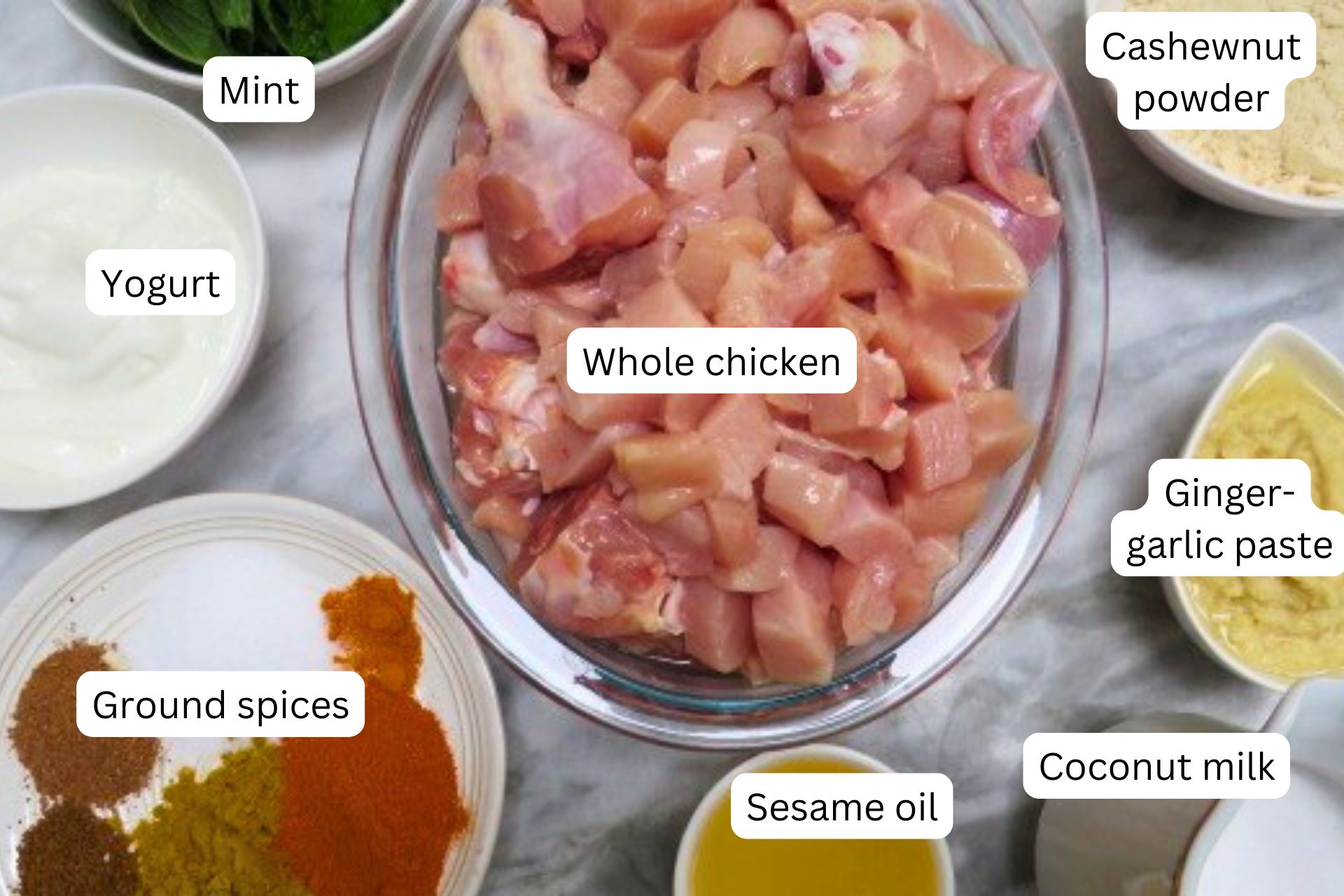
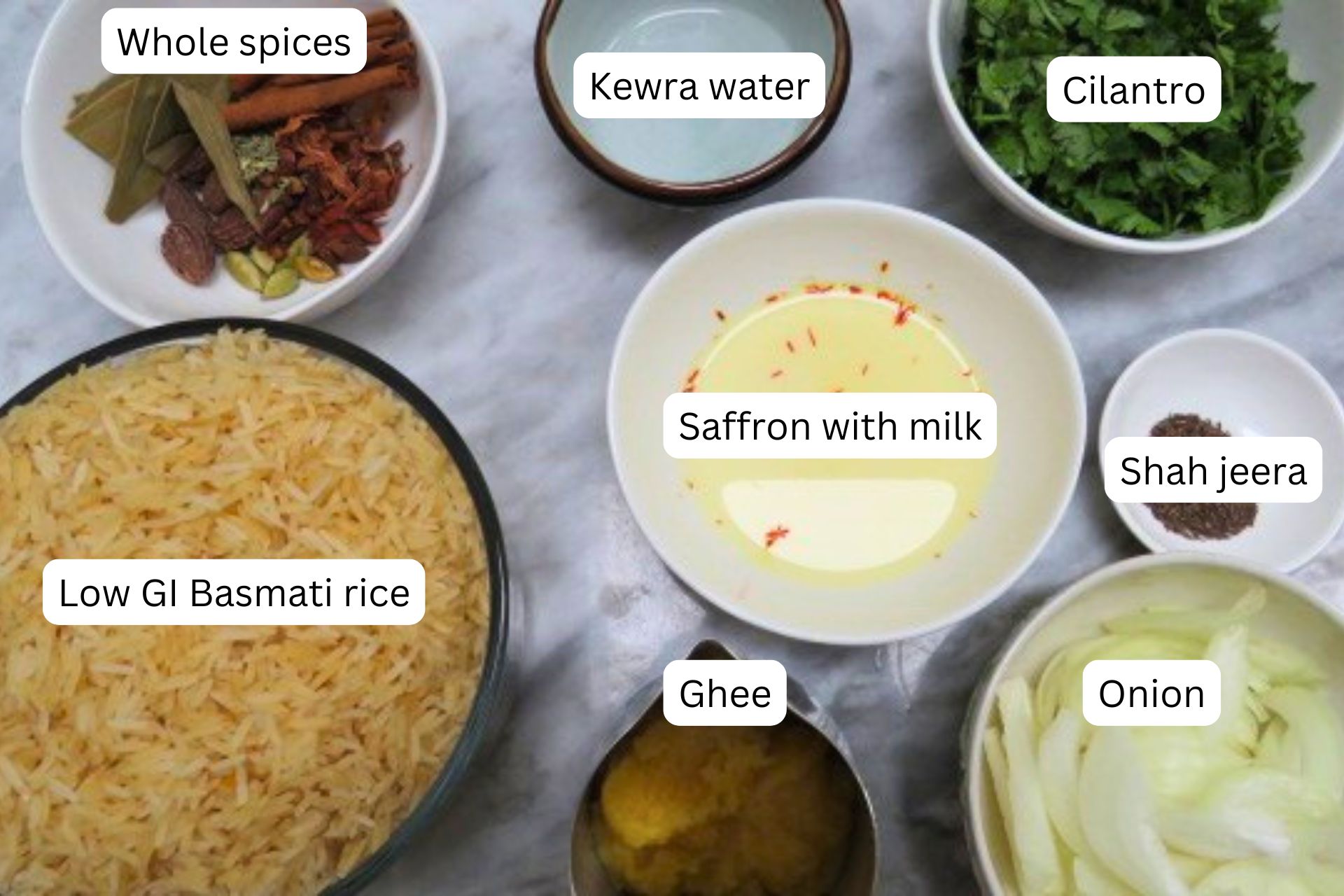
- Whole spices: cloves, green cardamom, cinnamon, black cardamom, shah jeera, fennel seeds, bay leaves
- Saffron
- Yogurt: Plain whole yogurt
- Kewra water:
- Ground spices: garam masala, turmeric, cumin, chili, and coriander
- Herbs: mint, cilantro
- Fat: sesame oil and ghee
- Meat: chicken; or use lamb or mutton
- Other ingredients: onion, ginger-garlic paste, roasted cashew nut powder
Here are the step-by-step instructions on how to make this dish. Please refer to the recipe card below for the measurements.
How to make Chicken Dum Biryani using my recipe:
Grind the ingredients for the marinade in a spice grinder. Marinate the cleaned chicken for 6 hours or overnight. In a Dutch oven or pan, heat a tablespoon of ghee. Add the shah jeera to temper it. Add the chicken with the marinade and cook on medium heat for 10-12 minutes or until it thickens. Set it aside.
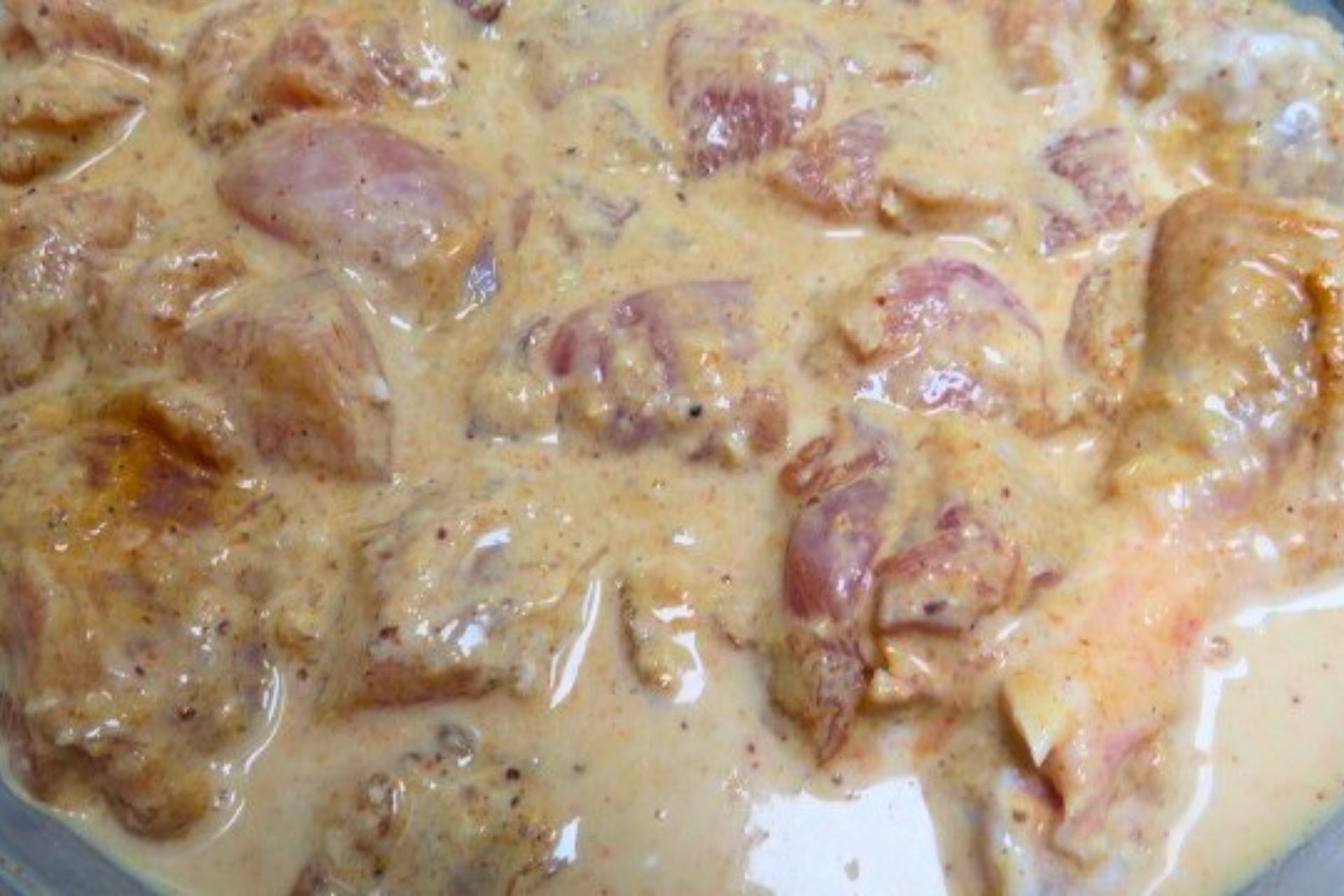
2. Sauté the sliced onions in a clay pot or Dutch oven with 2 tablespoons of sesame oil. Caramelize the onions by sautéing for 5-7 minutes or until caramelized. Keep most of the onions aside for layering the biryani and reserve some for garnish.
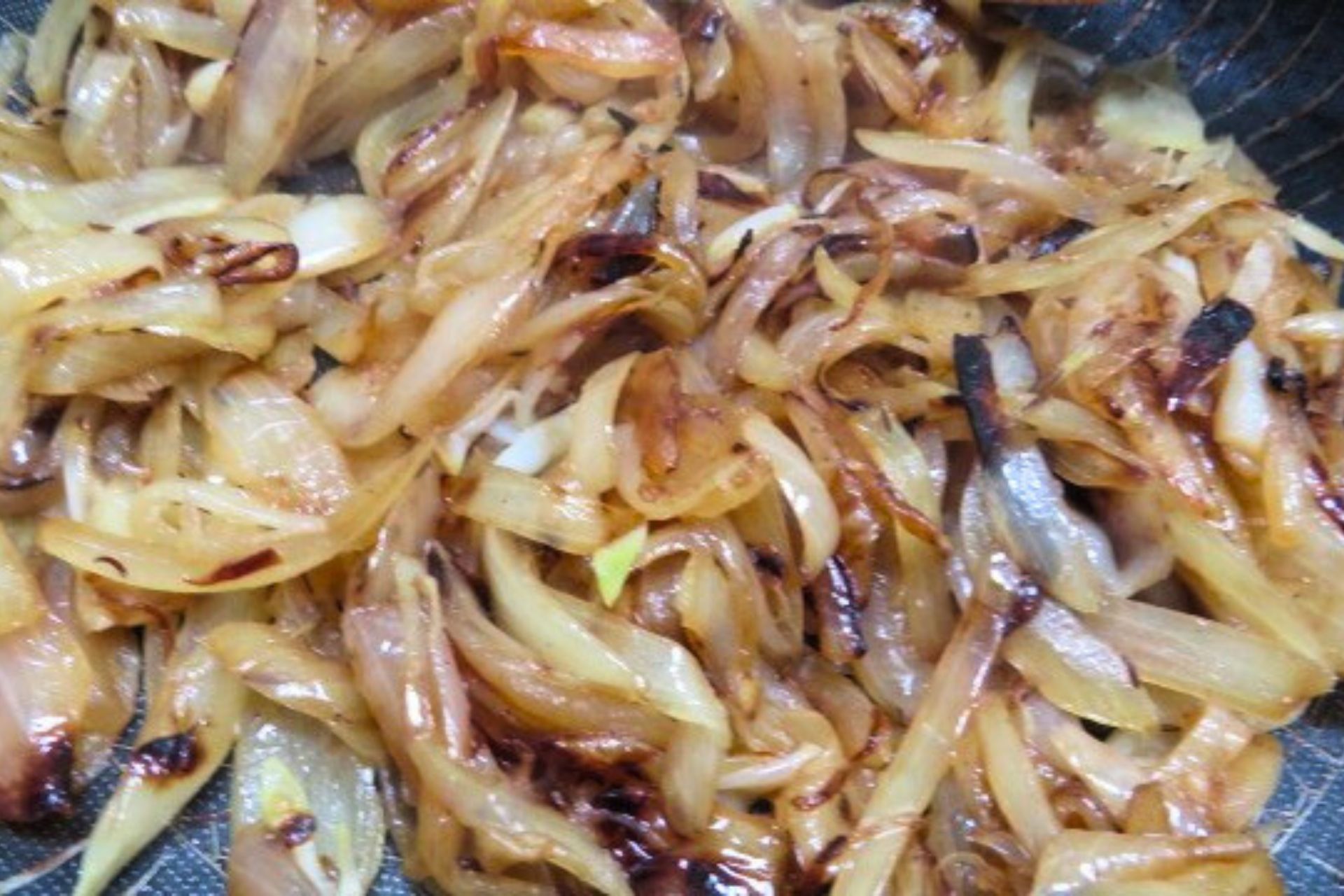
3. Boil water in another pot. Add the washed and soaked basmati rice with bay leaf, cinnamon, cloves, mace, black and green cardamom, salt, and a teaspoon of sesame oil. Boil the rice until it is only 75% cooked or partially cooked for 4 minutes. The rice must be grainy to the touch. Drain and set it aside.
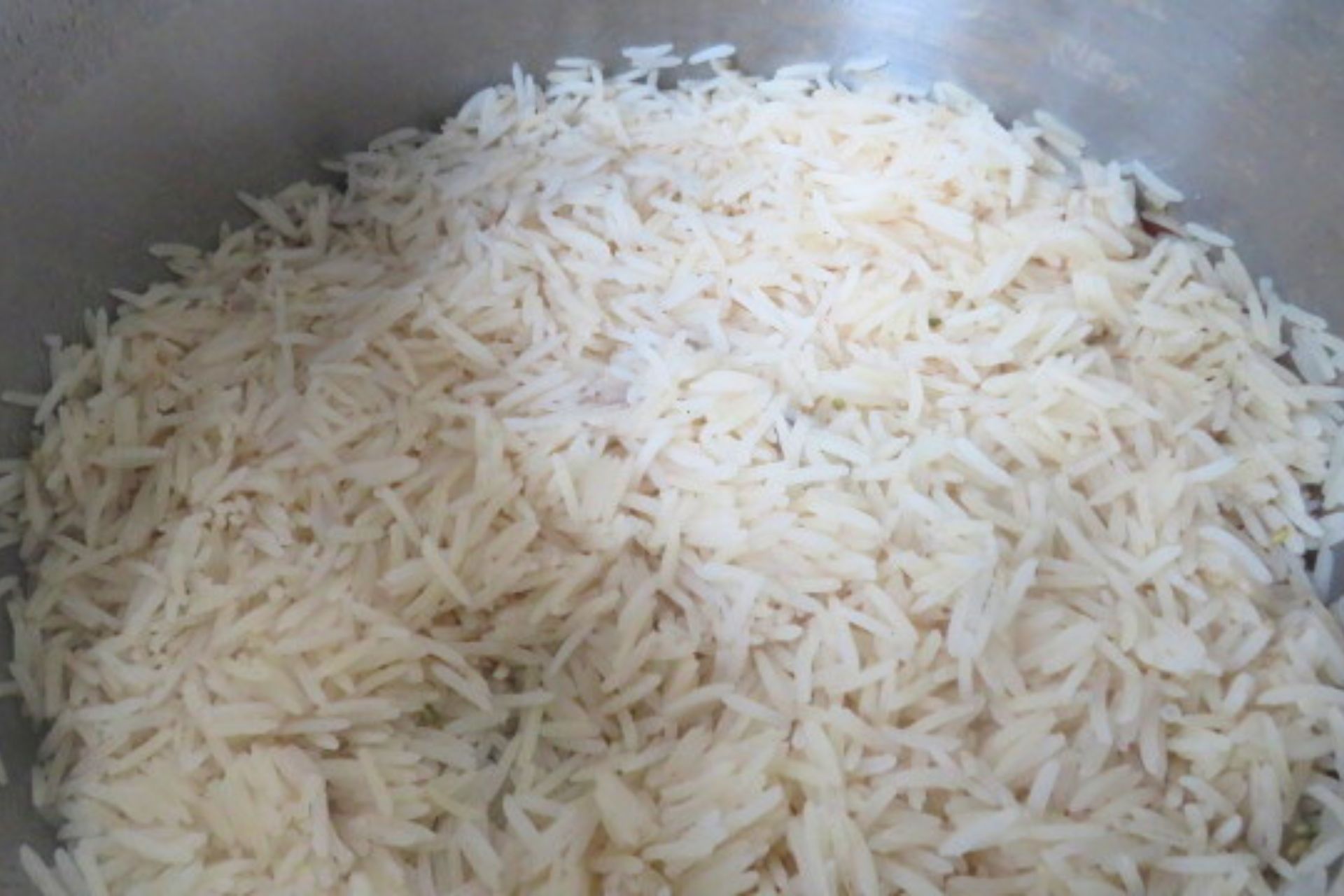
4. Layering the Chicken Dum Biryani: Start layering the Chicken Briyani using a third of the drained rice in the large clay pot. Drizzle a third of the ghee, saffron milk, kewra water, and the partially cooked chicken with the thickened sauce. Sprinkle some caramelized onions, fresh cilantro, and mint. Repeat this step three times and finally, top with caramelized onions, mint, and cilantro.
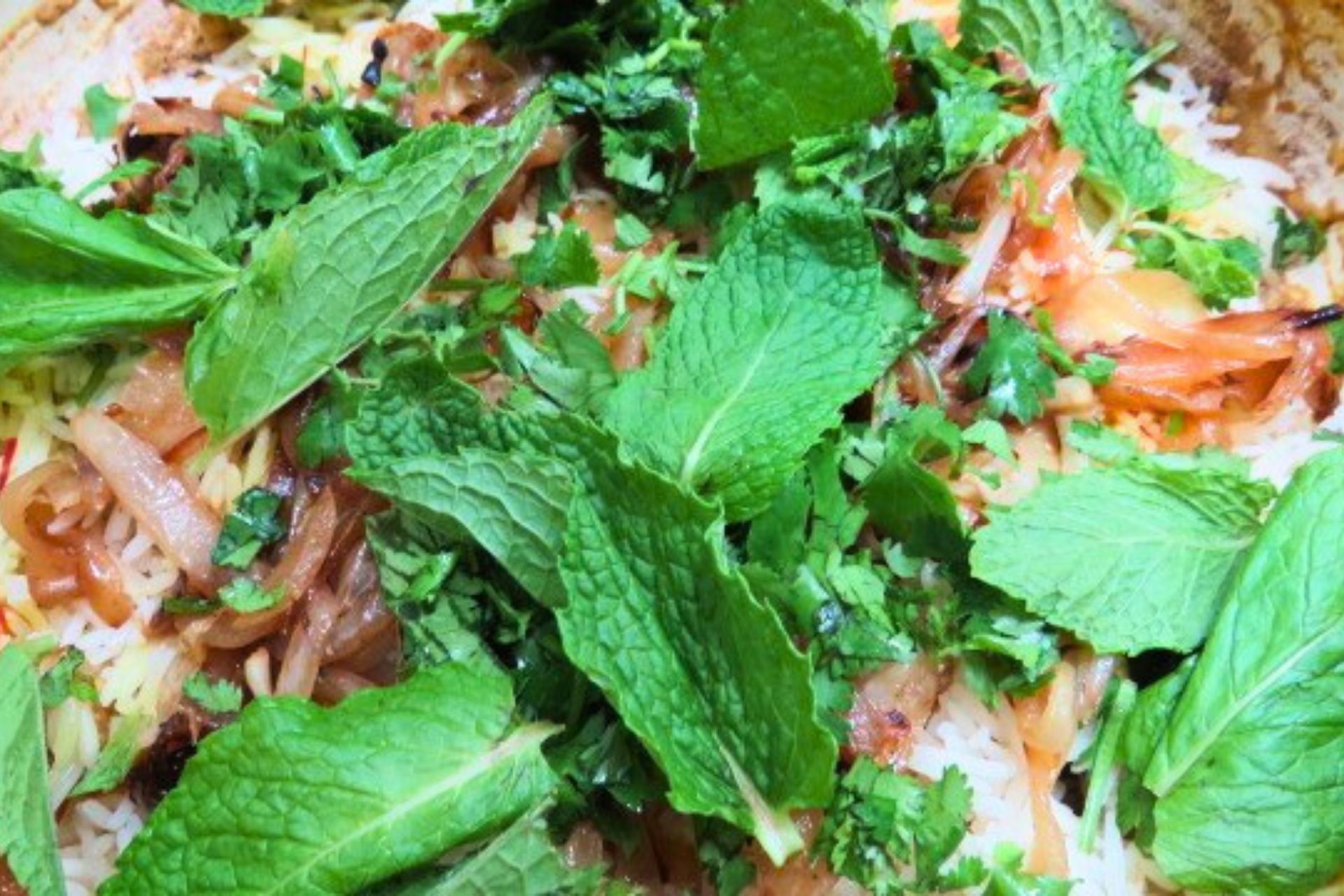
5. Roll the dough on a floured surface to a disc an inch larger in diameter than the clay pot’s rim. Place the disc on the pot’s rim and seal the clay pot. Press and seal the overhanging dough to the clay pot. Bake on low heat for 25-30 minutes or until the top of the dough is golden brown. Remove the clay pot from the oven and let it rest for 10 minutes. Cut open the dough lid with a sharp knife. Serve from the bottom up with raita and a hard-boiled egg.
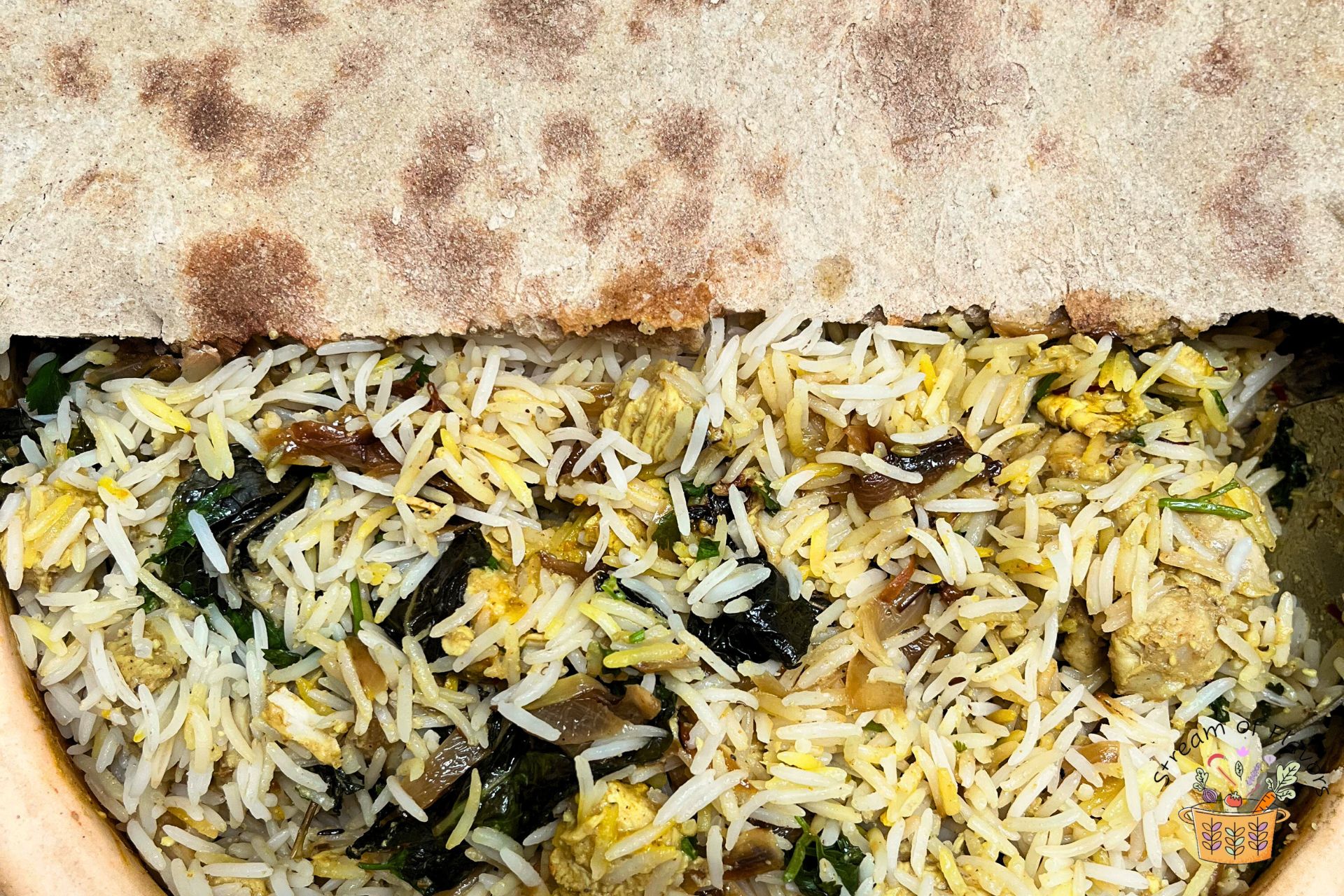
1. If cooking on the stovetop, cook on low heat or the biryani will get burned at the bottom of the pot. I like to place a griddle below the clay pot to prevent the biryani from burning. Instead of making a disc to cover the pot, stick a coil on the sides of the brim and place the clay pot’s lid on top.
2. The rice must be partially cooked (75% done) since it will be fully cooked in the clay pot during baking. The rice must be grainy to the touch to prevent it from becoming mushy after baking.
3. The chicken sauce must be cooked to a thick sauce. Runny sauce from the chicken will make the rice mushy at the end.
4. Chicken Dum Biryani is meant to be a colorful spectrum of white, orange, yellow, green, and brown. So do not mix up the chicken sauce and the rice. Just layer them carefully and seal the pot.
5. Good quality Basmati rice (I used low-GI Basmati rice) is essential for adding an aromatic fragrance to the biryani. Rinse the rice with cold water and soak it for 3-4 minutes to promote even cooking.
6. The chicken must be marinated for at least 2-3 hours or preferably overnight.
Storage:
Leftover Chicken Dum Biryani can be stored in airtight boxes and refrigerated. Re-steam the biryani without the dough seal. You can steam it in a steamer or microwave the biryani by sprinkling water and heating it with a lid.
Serving suggestions:
The traditional ‘dum’ biryani is served in the pardah, which makes for a tasty plate. They can also be served in the clay or copper handi, which is usually garnished with deep-fried onions (beresta) and a boiled egg on the side. Accompanying this can be a variety of condiments including a yogurt and onion salad (raita) and/or a very light meat curry (salan). Dum biryani is served on special occasions in India.
Other spicy chicken recipes that you might like:
- Chicken Pasanda
- Best Butter Chicken
- Malaysian Chicken Satay
- Panang Chicken Curry
- Indian Chicken Burger Recipe
Chicken Dum Biryani Recipe
Equipment
- Clay pot or Dutch oven (stovetop)
Ingredients
For the dough:
- 1½ cup whole wheat flour
- ½ cup water as needed
- a pinch salt
For the chicken marinade:
- 3½ lb whole chicken cut
- 3 tbsp ginger-garlic paste peeled, chopped
- 4 tbsp roasted cashew nut powdered
- 4 tbsp yogurt
- ½ tsp turmeric powder
- 3 tsp red chili powder
- 2½ tsp coriander powder
- 1 tsp ground cumin
- 1½ tsp garam masala powder
- ¾ cup coconut milk
- 2 tsp salt
For the dum biriyani:
- 1 tsp shah jeera
- 1½ tbsp sesame oil
- 5 onion sliced
- 1 tsp saffron
- 4 tbsp milk
- 4 cup low GI Basmati rice
- 1 tsp salt
- 2 cinnamon
- 2 bay leaf
- 3 mace
- 2 black cardamom
- 3 green cardamom
- 4 cloves
- 1 tsp fennel seed
- 5 tbsp clarified butter (ghee)
- 2 tbsp kewra water
- 1 cup cilantro chopped
- 1 cup mint chopped
Instructions
- Prepare the ingredients. Soak the saffron in warm milk. Wash the rice in cold water, soak it for 3-4 minutes and drain it.
- Prepare the remaining ingredients. Knead the dough and set aside.
- Grind the ingredients for the marinade in a spice grinder. Marinate the cleaned chicken for 6 hours or overnight. In a Dutch oven or pan, heat a tablespoon of ghee. Add the shah jeera to temper it. Add the chicken with the marinade and cook on medium heat for 10-12 minutes or until it thickens. Set it aside.
- Sauté the sliced onions in a clay pot or Dutch oven with 2 tablespoons of sesame oil. Caramelize the onions by sautéing for 5-7 minutes or until caramelized. Keep most of the onions aside for layering the biryani and reserve some for garnish.
- Boil 12 cups of water in another pot. Add the washed and soaked basmati rice with bay leaf, cinnamon, cloves, mace, black and green cardamom, salt, and a teaspoon of sesame oil. Boil the rice until it is only 75% cooked or partially cooked for 4 minutes. The rice must be grainy to the touch. Drain the rice using a sieve and set it aside.
How to layer the Chicken Dum Biryani:
- Preheat the oven to 350 degrees F.Start layering the Chicken Briyani using a third of the drained rice in the large clay pot. Drizzle a third of the ghee, saffron milk, kewra water, and the partially cooked chicken with the thickened sauce. Sprinkle some caramelized onions, fresh cilantro, and mint. Repeat this step three times and finally, top with caramelized onions, mint, and cilantro.
- Roll the dough on a floured surface to a disc that is an inch larger in diameter than the clay pot's rim. Place the disc on the pot's rim and seal the clay pot. Press and seal the overhanging dough to the clay pot. Bake at 350 degrees F on low heat for 25-30 minutes or until the top of the dough is golden brown. Remove the clay pot from the oven and let it rest for 10 minutes. Cut open the dough lid with a sharp knife. Serve from the bottom up with raita and a hard-boiled egg.
Notes
- Adjust the size of the dough disc to the rim of the pot you use.
- The dum biryani must be layered and cooked, so do not mix it before cooking.
- To serve this dish, scoop from the bottom up, ensuring you get layers of chicken, rice, and onions.
- Place the sealed clay pot in the center rack of the oven.
Nutrition



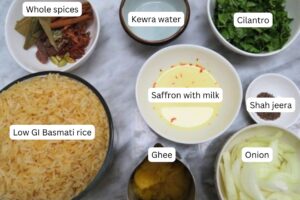

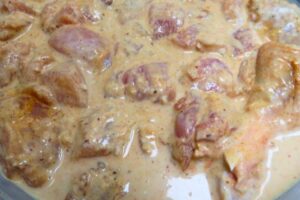
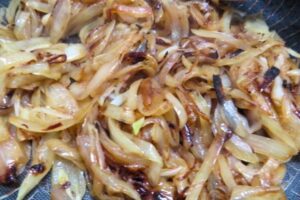
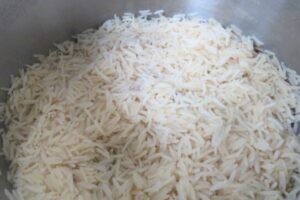
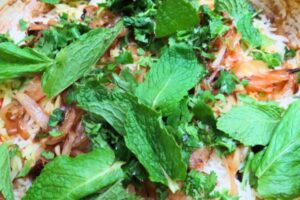
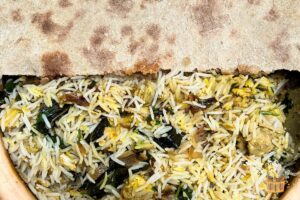




















A traditional Indian dish executed perfectly! Well done Kanchan!
Thanks, Ishani!
thanks for showing how to make the dough – I’ve always gotten stuck there.
This is SO GOOD!! I tried this recipe and its so much better than the nasi briyani we get at the even th best restaurants I have tried. But what’s even amazing is that it tested even better on the 2nd day. I have Indian friends who have said that to me before, but this is the first time I have tried to make biriyani and my family loved it. Big fan!!
I am very happy to hear that, thank you!